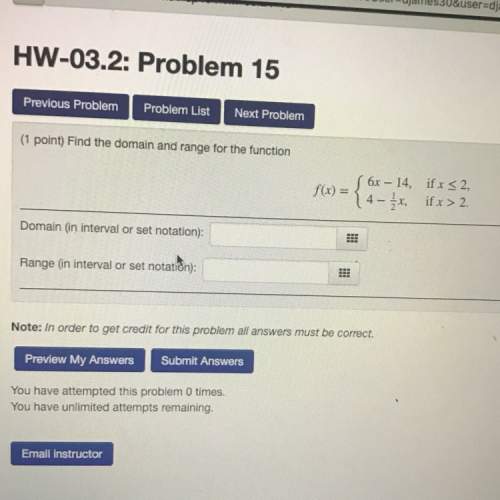
Mathematics, 02.12.2021 01:50 johnsont8377
Finding the Equation of a Polynomial Function
In this section we will work backwards with the roots of polynomial equations or zeros of polynomial
functions. As we did with quadratics, so we will do with polynomials greater than second degree. Given
the roots of an equation, work backwards to find the polynomial equation or function from whence they
came. Recall the following example.
Find the equation of a parabola that has x intercepts of (−3,0 2,0 . ) and ( )
(−3,0 2,0 . ) and ( ) Given x intercepts of -3 and 2
x x =− = 3 2 If the x intercepts are -3 and 2, then the roots of the equation are -3 and 2. Set each
root equal to zero.
( x x + − 3 2 ) ( ) For the first root, add 3 to both sides of the equal sign.
For the second root, subtract 2 to both sides of the equal sign.
2
x x + − 6 Multiply the results together to find a quadratic expression.
2
yx x = +−6 Set the expression equal to y, or ( x) f , to write as the equation of a parabola.
The exercises in this section will result in polynomials greater than second degree. Be aware, you may not
be given all roots with which to work.
Consider the following example:
Find a polynomial function that has zeros of 0, 3 2 3 and i + . Although only three zeros are given here,− −+ . Multiplying

Answers: 3


Another question on Mathematics

Mathematics, 22.06.2019 01:30
When solving a logarithm equation, how do you find the missing variable ?
Answers: 2

Mathematics, 22.06.2019 02:00
Part a what is the area of triangle i? show your calculation. part b triangles i and ii are congruent (of the same size and shape). what is the total area of triangles i and ii? show your calculation. part c what is the area of rectangle i? show your calculation. part d what is the area of rectangle ii? show your calculation. part e rectangles i and iii have the same size and shape. what is the total area of rectangles i and iii? show your calculation. part f what is the total area of all the rectangles? show your calculation. part g what areas do you need to know to find the surface area of the prism? part h what is the surface area of the prism? show your calculation. part i read this statement: “if you multiply the area of one rectangle in the figure by 3, you’ll get the total area of the rectangles.” is this statement true or false? why? part j read this statement: “if you multiply the area of one triangle in the figure by 2, you’ll get the total area of the triangles.” is this statement true or false? why?
Answers: 1

Mathematics, 22.06.2019 02:00
Brittany has designed four different birdcages, each with the same volume: a square pyramid, a cylinder, a cone, and a sphere. the zoo wants to use one of brittany’s designs but plans to change the volume of the cage. find the design change that would result in the birdcage with the greatest volume. a.) increase the area of the base of the square pyramid by a factor of ten. b.) increase the height of the cylinder by a factor of ten. c.) increase the radius of the cone by a factor of ten. d.) increase the radius of a sphere by a factor of ten.
Answers: 1

Mathematics, 22.06.2019 02:00
An amusement park manager determined that about 23 of all customers would wait in long lines to ride the new roller coaster. which simulation could not be used to answer questions about whether a customer would wait?
Answers: 1
You know the right answer?
Finding the Equation of a Polynomial Function
In this section we will work backwards with the root...
Questions


Mathematics, 22.07.2021 18:30





















